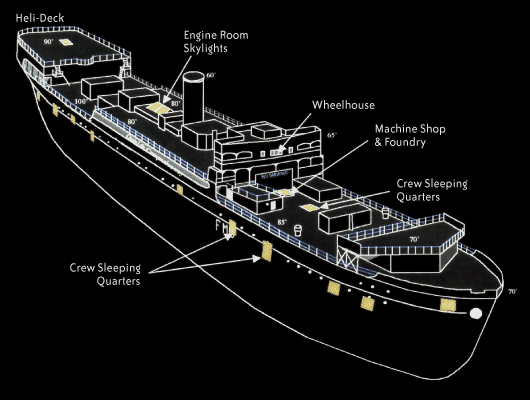
The Cape Breton
Diving the Artificial Reefs
Since 1991 the Artificial Reef Society has sunk 6 ships and one aircraft. By far the most interesting of them all has to be the former HMCS Cape Breton. Sunk in October 2001 while the aftermath of 9/11 was still ringing in our ears the wreck of the Cape Breton was sunk in a show of pyrotechnics fit for a Hollywood movie. In fact the explosives were reported to be left over from a movie filmed in Vancouver that the venerable old ship starred in. The Cape Breton is a giant among artificial reefs of the world , she was the largest before the sinking of the Spiegel Grove in May 2002. At 120m in length and over 15m high she is a sight to behold an her form takes shape below the water upon your decent.

I had the pleasure to live and work on this vessel when it was used by the Canadian Navy as a floating machine shop, repair facility and crews quarters. We didn't make much money in those days so I had plenty of evenings where I had nothing better to do than explore the bowels of the old ship. I am glad now I did. I used to be amazed by the old triple expansion steam engine and the boilers that rose 3 stories from the keel. I also worked both in the machine shop and in the foundry where we cast brass and aluminum using sand molds.
The first time I dove the Cape Breton was a couple of days after the sinking. The paint seemed bright and clean and there was no marine growth on it. It sits almost upright in 40m of water and the top of the funnel sits at about 20m. When I first came down the line the water was crystal clear. You could see almost from stem to stern and since it was so new it was easy to imagine seeing the ghosts of former sailors walking the decks. She has been down a few years now and the marine life must really enjoy the location. The upper decks around the bridge is festooned with giant white plumose anemones. There are multitudes of fish and invertebrates all through the interior and exterior.
One of the most enjoyable aspects of this wreck for me is exploring the inner passageways. I have probably been through every inch of that wreck over the years but I still get a thrill when dropping five decks through the skylights and into the engine room. The single engine has been removed which leaves a big open area for divers to explore. On the aft bulkhead you will see three giant concentric circles. Those are the spare piston rings. That gives you and idea of how big the engine was. If you are penetrating the wreck you can place a primary tie-off inside the engine room and pass through one of the doors about midway up the engine room bulkheads. If you exit on the starboard side and turn left you will be in a narrow passage moving forward. You will see to your right the area where food was served to the crew. The galley is actually one deck up. You will soon come to a big wide open room which was the cafeteria. Passing through the next door forward will take you to the crews mess (sleeping area) which is another huge open room. Continue forward and you will come to a much tighter area where you can find many rooms to explore including the crews heads and one deck down is the sailmakers workshop and numerous store rooms.
Although much of the third deck is cut out for easy access, this forward area has lots of closed in spaces and overhead training and guideline protocol is a must. Due to the depth of the wreck you will find exploring the innards will get you into deco pretty quickly. Carrying a deco gas for this dive and being prepared for a bit of a hang is a good idea. You will also want a good lift bag and reel since the visibility is sometimes not great on the upper deck and finding the upline is never a certainty.
If you are diving toward the stern be sure and pay your respects by visiting the plaque laid in memory of our friend Daniel which lies at the very stern two decks below the flight deck on the outer part of the ship. This plaque is a grim reminder to use proper overhead protocol when entering any of these seemingly benign artificial reefs. This plaque marks the area where Daniel entered the Cape Breton for the very last time.
Have fun but dive safe.